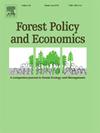生态快速和经济最优森林恢复设计之间的错位
IF 4
2区 农林科学
Q1 ECONOMICS
引用次数: 0
摘要
由于森林恢复的效益需要很长时间才能实现,因此在设计恢复项目时应考虑到代际公平,特别是考虑到承担费用的那一代人的观点和感受。我们使用支付卡在日本公众中进行了一项条件评估调查,以关注Shiretoko国家公园的森林恢复,以估计碳和生物多样性恢复的个人贴现率。具体而言,我们提出了两种不同恢复时间的森林恢复方案,并询问了他们对每种方案的支付意愿(WTP)。从WTP的这些差异来看,个人贴现率估计为1.17%。利用估算的贴现率,对31种不同种植密度和种植物种数量的不同恢复方案的模拟结果进行了成本效益分析。我们还使用常用的贴现率4.0%和6.0%进行了相同的分析。结果表明,生态最优恢复方案与经济最优恢复方案存在差异,经济最优恢复方案随贴现率的变化而变化。这突出表明需要谨慎地建立共识,将森林生态系统管理中的生态和经济观点结合起来。本文章由计算机程序翻译,如有差异,请以英文原文为准。
Misalignment between ecologically rapid and economically optimal forest restoration designs
Because the benefits of forest restoration take a long time to materialize, it is desirable to design restoration projects with intergenerational equity in mind, particularly considering the perspectives and feelings of the generation bearing the costs. We conducted a contingent valuation survey with a payment card among the Japanese public focusing on forest restoration in Shiretoko National Park to estimate individual discount rates for carbon and biodiversity recovery. Specifically, we presented two forest restoration scenarios with varying recovery times and asked for their willingness to pay (WTP) for each. From these differences in WTP, the individual discount rates were estimated at 1.17 %. Using the estimated discount rates, cost-benefit analyses were performed on the simulation results of 31 different restoration scenarios with varying planting densities and number of species planted. We also performed the same analyses using commonly used discount rates of 4.0 % and 6.0 %. The results showed a divergence between the ecologically and economically optimal restoration scenarios, and that the economically optimal restoration scenario varied depending on the discount rate. This highlights the need for careful consensus building that combines ecological and economic perspectives in forest ecosystem management.
求助全文
通过发布文献求助,成功后即可免费获取论文全文。
去求助
来源期刊

Forest Policy and Economics
农林科学-林学
CiteScore
9.00
自引率
7.50%
发文量
148
审稿时长
21.9 weeks
期刊介绍:
Forest Policy and Economics is a leading scientific journal that publishes peer-reviewed policy and economics research relating to forests, forested landscapes, forest-related industries, and other forest-relevant land uses. It also welcomes contributions from other social sciences and humanities perspectives that make clear theoretical, conceptual and methodological contributions to the existing state-of-the-art literature on forests and related land use systems. These disciplines include, but are not limited to, sociology, anthropology, human geography, history, jurisprudence, planning, development studies, and psychology research on forests. Forest Policy and Economics is global in scope and publishes multiple article types of high scientific standard. Acceptance for publication is subject to a double-blind peer-review process.
 求助内容:
求助内容: 应助结果提醒方式:
应助结果提醒方式:


